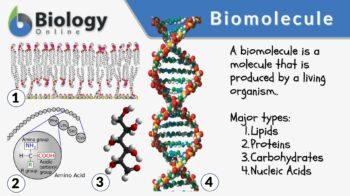
Biomolecule
n., plural: biomolecules
[baɪoʊ ˈmɑləkjul]
Definition: Any of the molecules produced by living organisms
Table of Contents
A molecule is an electrically neutral, group of atoms that can exist alone in a free state while its characteristic properties are retained. The atoms comprising the molecule may be of the same kind (as in an oxygen molecule made up of two oxygen atoms) or of different kinds (such as a water molecule made up of oxygen and hydrogen).
In biology and biochemistry, a molecule is a term used less strictly that it can also refer to any minute particle such as charged organic molecules or to substances (called biomolecules) that are produced and occur naturally in living organisms. Biomolecules include proteins, carbohydrates, lipids, and nucleic acids.
Biomolecule Definition
A biomolecule refers to any molecule that is produced by living organisms. As such, most of them are organic molecules. The four major groups of biomolecules include polysaccharides, proteins, nucleic acids (DNA and RNA), and lipids. They are found in and produced by living organisms. Thus, many of the biomolecules are polymers. A polymer is a compound made up of several repeating units (monomers) or protomers and produced by polymerization.
Most of these biomolecules are organic compounds. Being “organic” means, in general, they contain carbon atoms covalently bound to other atoms, especially Carbon-Carbon (C-C) and Carbon-Hydrogen (C-H). The four major element constituents are carbon, hydrogen, oxygen, and nitrogen.
Etymology
- Ancient Greek βίος (bíos, meaning “life”)
- French molécule, from New Latin molecula (“a molecule”)
Synonym
- biological molecule
Derived term
- biomolecular (adjective, of, pertaining to, relating to, or characterizing a biomolecule)
Nucleic Acid Biomolecules
A nucleic acid is a biomolecule composed of monomeric units of nucleotides. Each nucleotide, in turn, is comprised of phosphoric acid, sugar (5-carbon), and a nitrogenous base. The chains of nucleotides in a nucleic acid are linked by 3′, 5′ phosphodiester linkages.
Nucleic acids may be in the form of DNA or RNA molecules containing the genetic information important for all cellular functions and heredity. Conversely, a nucleoside is a biomolecule formed when a nucleobase is attached to a ribose or a deoxyribose. Examples include cytidine, uridine, adenosine, guanosine, and thymidine.
Nucleosides that are phosphorylated become nucleotides. Apart from serving as a structural unit of nucleic acids, nucleotides may also serve as sources of chemical energy (e.g. adenosine triphosphate or ATP). Nucleotides may also act as cofactors of some enzymatic reactions (e.g. flavin adenine dinucleotide or FAD, nicotinamide adenine dinucleotide phosphate or NADP).
DNA, or deoxyribonucleic acid, is a double-stranded nucleic acid containing the genetic information of a living thing. It is composed of two strands that twist together to form a helix. Each strand consists of alternating phosphate and pentose sugar (2-deoxyribose), and attached to the sugar is a nitrogenous base, which can be adenine, thymine, guanine, or cytosine. DNA is essential for the cell growth, division, and function of an organism.
RNA, or ribonucleic acid, is a nucleic acid that is generally single-stranded and composed of repeating nucleotide units of the ribose sugar, a phosphate group, and a nitrogenous base. It consists of a long linear chain of nucleotides where each nucleotide is comprised of a sugar, phosphate group, and a nitrogenous base. It differs from a DNA molecule in a way that the sugar backbone is a ribose (deoxyribose in DNA) and the bases are adenine, guanine, cytosine, and uracil.
Both DNA and RNA are biopolymers of repeating units of mononucleotides and in essence are comprised of carbon, hydrogen, oxygen, nitrogen, and phosphorus.
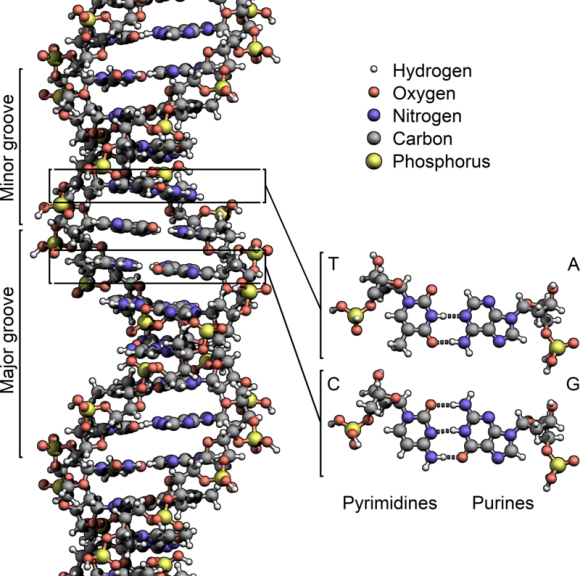
Protein Biomolecules
A protein is a biomolecule composed of amino acids joined together by peptide bonds. An amino acid is a molecule consisting of the basic amino group (NH2), the acidic carboxylic group (COOH), a hydrogen atom, and an organic side group (R) attached to the carbon atom.
Hence, it has the basic formula of NH2CHRCOOH. Amino acids are classified as to whether they are non-essential or essential. Non-essential (or dispensable) amino acids are synthesized in the body. Essential (or indispensable) amino acids cannot be synthesized in the body and can only be obtained through food.
There are about a hundred natural amino acids identified. Twenty of them are involved in making up a protein. Proteins are essential as they serve various biological functions: as a structural material (e.g. keratin), as enzymes, as transporters (e.g. hemoglobin), as antibodies, or as regulators of gene expression.
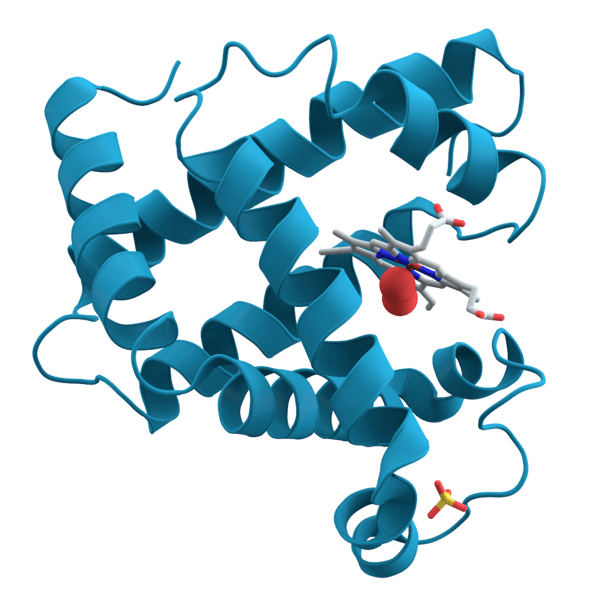
Carbohydrate Biomolecules
Carbohydrates are the most abundant among the major classes of biomolecules. Most of the carbohydrates follow the general formula: Cn (H2O) n, from where they derive their name, which means hydrates of carbon. However, not all carbohydrates follow this formula and are slightly different in structure from this rule.
Chemically, they are simple organic compounds that are aldehydes or ketones with many hydroxyl groups added usually on each carbon atom not part of the aldehyde or ketone functional group.
Saccharide is the structural (monomeric) unit of carbohydrates. Based on the number of monomeric units, carbohydrates may be monosaccharides, disaccharides, oligosaccharides, or polysaccharides.
- Monosaccharides are carbohydrates of only one simple sugar. Examples are glucose, fructose, and galactose. They are the most fundamental type of carbohydrates.
- Disaccharides are carbohydrates made up of two monosaccharide units. Examples are sucrose, maltose, and lactose.
- Oligosaccharides are those consisting of two to ten simple monosaccharide units. Examples are raffinose, maltotriose, and maltotetraose.
- Those with a larger number of monosaccharide units are called polysaccharides. Examples are starch, cellulose, and glycogen. When a polysaccharide is made up of monosaccharide units of the same type it is referred to as a homopolysaccharide (or homoglycan) whereas a polysaccharide is comprised of more than one type of monosaccharide it is called heteropolysaccharide (or heteroglycan).
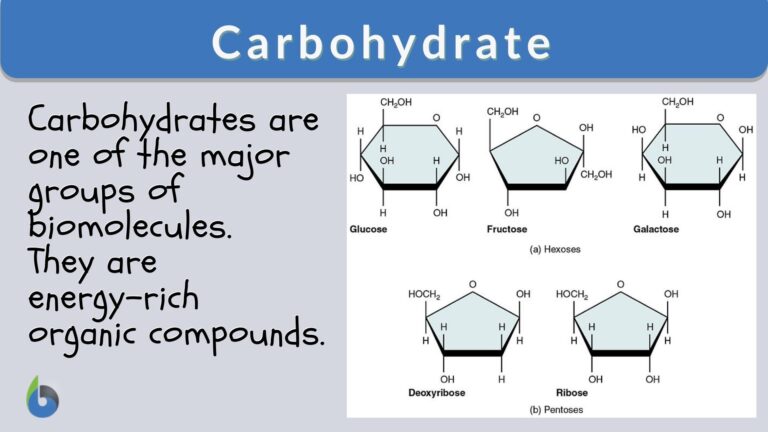
Lipid Biomolecules
Lipids are organic compounds that are readily soluble in a nonpolar solvent (e.g. ether) but not in a polar solvent (e.g water). Their major biological functions involve energy storage, the structural component of the cell membrane, and cell signaling. In biological membranes, the lipid component has a hydrophilic head that may be a glycolipid, a phospholipid, or a sterol (e.g. cholesterol) and a hydrophobic tail.
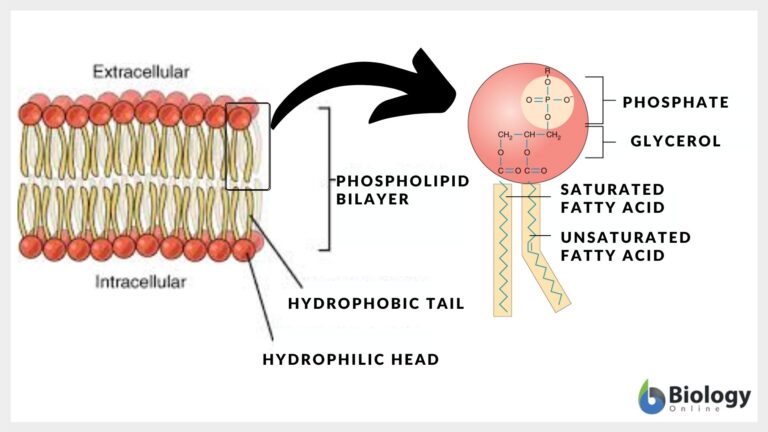
Other Biomolecules
Other biomolecules are metabolites and natural products. A metabolite refers to any substance produced by metabolism or by a metabolic process. Examples of metabolites are alcohols, amino acids, antioxidants, nucleotides, organic acids, vitamins, polyos, alkaloids, terpenoids, etc. Natural products include biologically-derived materials, bio-based materials, and bodily fluids.
Research
Molecular biology and biochemistry are two subfields of biology that study biomolecules and their reactions. Molecular biology, in particular, studies the structure and activity of macromolecules essential to life (and especially with their genetic role). It is the study of biology at the molecular level, such as the chemical properties of DNA.
Biochemistry is the study of the structure and function of cellular components, such as proteins, carbohydrates, lipids, nucleic acids, and other biomolecules, and of their functions and transformations during life processes.
Answer the quiz below to check what you have learned so far about biomolecules.
Further reading
- nucleic acid
- protein
- carbohydrate
- lipid
- molecule
© Biology Online. Content provided and moderated by Biology Online Editors


